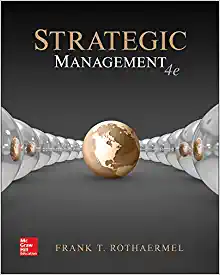We have studied the differences in business-level strategies closely in this chapter, but how might these differences
Question:
We have studied the differences in business-level strategies closely in this chapter, but how might these differences relate directly to you? As you’ve learned, firms using a differentiation strategy will focus on drivers such as product features and customer service, while firms using a cost-leadership strategy will prioritize cost of inputs and economies of scale. These strategic decisions can have an impact on an employee’s experience with the firm’s work environment and culture. Nordstrom, Whole Foods Market (before its 2017 acquisition by Amazon), and Wegmans Food Markets are companies that routinely end up on Fortune’s list of “100 Best Places to Work.” These companies use a differentiation business strategy. In contrast, Amazon and Walmart use the cost-leadership strategy; and as low-cost leaders, they do not rate nearly as well. According to inputs from the employee review site Glassdoor.com, only 50 percent of the employees working at Walmart would recommend the firm to a friend. Compare this to the 72 percent who would recommend both Nordstrom and Whole Foods, and the 80 percent who would recommend Wegmans Food Markets. As for Whole Foods, some industry watchers believe Amazon will enact the same tactics in dealing with workers at Whole Foods as it has applied to its own warehouse workers, leading to a low rating of employee satisfaction. As you seek options for starting or growing your career, carefully consider the strategy the firm takes in the marketplace. By no means should you avoid low-cost leaders in lieu of strong differentiators (nor should you deem all differentiators as great places to work). Fast-paced organizations that focus on driving tangible results for the organization offer much to learn. For example, Amazon has been a very successful company for the past decade, and many employees have had multiple opportunities to learn enormous amounts in a short period. The firm has also made HR and cultural changes after a scathing New York Times article about its “bruising workplace.” Amazon has reportedly eliminated the practice of forcing employee rankings to follow a normal curve with only a small percentage getting top scores. Amazon employees are encouraged to criticize each other’s ideas openly in meetings; they work long days and on weekends; and they strive to meet “unreasonably high” standards. “When you’re shooting for the moon, the nature of the work is really challenging. For some people it doesn’t work,” says Susan Harker, a top recruiter for Amazon. The high standards and relentless pace are a draw for many employees who are motivated to push themselves to learn, grow, and create—perhaps beyond their perceived limits. Many former employees say the nimble and productive environment is great for learning and the Amazon experience has really helped their careers expand. Now consider the following questions.
1. Employees and consultants say the Amazon workplace is the epitome of a “do more for less cost” environment. We recognize this is a hallmark goal of a cost-leadership business strategy. But ask yourself this key question, Is it the type of high-pressure work environment in which YOU would thrive?
2. Amazon has surpassed 350,000 employees, adding more than 100,000 employees in 2016 alone! The company will be offering bold new ideas and moving Amazon toward being the first trillion-dollar retailer under an intense pressure to deliver on its goals. The allure from this type of success is compelling and offers tremendous rewards to many employees, shareholders, and customers. What aspects of success are you seeking in your professional career?
3. Before you launch into a new project, job, or firm, or even before you make a change in industry in the effort to move forward in your career, always consider the trade-offs that you would and would not be willing to make.
Step by Step Answer:






